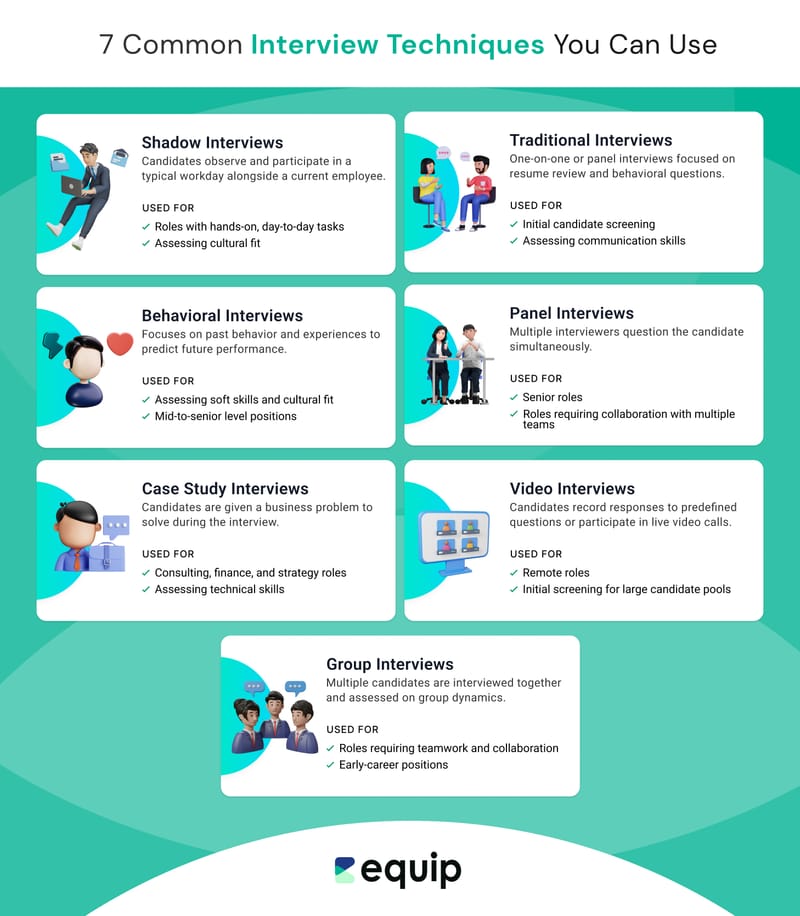
Although you can learn a lot about a candidate through assessments, interviews, and their CV, the truth is that you won’t know how they’ll truly act as an employee until they’re doing the work.
That’s why a shadow interview – a hands-on way for potential hires to “shadow” a current employee – can be so helpful. Whether you’re narrowing down a best-fit candidate between a pool of equally qualified talent or are gearing up to offer a candidate the position but want a final confirmation that they’re the best-fit hire, a shadow interview can give you the peace of mind you need that you’re making the most well-informed decision about a new hire.
To help you learn the ins and outs of shadow interviews and how they can help your hiring strategy, we’ve gathered everything you need to know.
What is a Shadow Interview?
A shadow interview is a time for potential hires to look at the day-to-day operations of the organization and gain a better understanding of what their role would consist of, the interactions they may have with clients or customers, and the departments that a new employee would be heavily involved with.
Although traditional interviews can help recruiters glean insights into how an employee may respond to situations, such as through real-time customer simulations or assessments, everything is theoretical. You won’t know for sure whether the employee will truly integrate with the rest of the organization and align with its goals until the employee is actively submersed in the organization’s daily operations.

Although a shadow interview still can’t give you a foolproof answer on whether an employee will thrive in their role, it can give you a more practical view of how an employee may perform than a traditional question-and-answer interview, which can help reduce the likelihood of a costly bad-fit hire.
Not only can a bad-fit hire be costly, but it’s incredibly common: 75% of employers report hiring the wrong person, according to a CareerBuilder report.
Interview Shadowing: Job Shadow v Reverse Shadow
It’s important to understand the difference between a job shadow interview and reverse shadowing. While job shadowing is a process where a potential candidate “shadows” a current employee, reverse shadowing flips the concept around. A more experienced employee – such as a manager – “shadows” a newer employee to assess their performance and development.
Shadow interview process
The process for a shadow interview can vary greatly depending on a breadth of factors, such as industry, organization size, work location, and more.
Before beginning to coordinate a shadow interview, it’s important to consider the employee who will be shadowed and prepare for the responsibility. Ensure that you don’t just randomly select an employee to be shadowed. Instead, be intentional and choose an employee who’s well-aligned with the open position’s responsibilities, and who will be able to assess the candidate’s skills while simultaneously showing the candidate the expectations and daily duties of the position.
You may need to coordinate with their team to ensure that any important work is delegated beforehand. Usually, the shadowed employee will be more invested in observing and evaluating the candidate, since they are working one-on-one with them, and may not be as productive as they typically are.
Although shadow interviews are typically one-on-one, depending on the organization’s structure and team dynamics, a candidate may shadow multiple people or may switch off between two employees throughout the day.
A typical shadow interview may include the following steps:
- Briefing the employee being shadowed on the schedule, objectives, and expectations for the shadow interview, and setting expectations for the interview candidate
- Providing a brief orientation about the organization and the shadowed employee, and provide a schedule with the day’s itinerary
- Observing the candidate throughout the day and taking note of important factors, such as how they interact with the team, their initiative to learn, or how they interact with clients or customers
- Evaluating the candidate’s interview in terms of the pre-defined goals and objectives, and allowing the candidate to self-assess how they believe the day went
Goals of a shadow interview
A shadow interview has the overarching goal of finding the best-fit candidate for the position. However, there are usually smaller goals and objectives that organizations will set for a shadow interview to help guide the evaluation of a candidate.
For example, during a shadow interview, you may be on the lookout for how well the employee fits in with the organization’s culture, or how they interact with their team. For more technical roles, you may be looking for proficiency in the skills needed for the position.
Knowing the goals beforehand, and prioritizing tasks during a shadow interview that can help achieve those goals, can ensure that the shadow interview is as effective as it can be.
How shadow interviews enhance the hiring process
There are many benefits to using shadow interviews to find a best-fit hire. Compared to a traditional interview, a shadow interview can give you a wealth of information that you wouldn’t be able to get otherwise, which can help reduce time-to-hire and ensure a potential hire is equipped to handle their new responsibility.
Here’s how shadow interviews can help enhance the hiring process, compared to a traditional interview process:
- Shadowed employees are able to observe and give feedback about how a candidate may fit in with the team and their predicted performance
- Leaders can confirm that candidates have the necessary skill set and competencies to succeed in their role
- Potential employees get a “trial run” of the job, reducing the likelihood they accept the job and then decide it isn’t the right fit, which is especially important as the rates of employees “quick quitting” is on the rise
Comparing Shadow Interviews with Other Common Interview Techniques
Interview Technique | Description | Pros | Cons | Best Used For |
|---|---|---|---|---|
Shadow Interviews | Candidates observe and participate in a typical workday alongside a current employee. | - Provides real-world insight into the job and company culture - Allows employers to assess practical skills | - Time-consuming - May be intimidating for candidates - Not standardized, hard to compare candidates | - Roles with hands-on, day-to-day tasks - Assessing cultural fit |
Traditional Interviews | One-on-one or panel interviews focused on resume review and behavioral questions. | - Familiar and widely accepted - Easy to standardize for comparison | - Limited insight into practical skills - Can be influenced by interviewer's biases | - Initial candidate screening - Assessing communication skills |
Behavioral Interviews | Focuses on past behavior and experiences to predict future performance. | - Helps identify soft skills and problem-solving abilities - Structured format reduces biases | - Relies on candidate's ability to articulate past experiences - May not reveal practical skills | - Assessing soft skills and cultural fit - Mid-to-senior level positions |
Panel Interviews | Multiple interviewers question the candidate simultaneously. | - Provides multiple perspectives - Reduces individual interviewer bias | - Can be intimidating for candidates - Difficult to coordinate schedules | - Senior roles - Roles requiring collaboration with multiple teams |
Case Study Interviews | Candidates are given a business problem to solve during the interview. | - Demonstrates problem-solving and analytical skills - Closely mimics real job challenges | - May favor candidates with prior exposure to similar cases - Time-intensive to evaluate | - Consulting, finance, and strategy roles - Assessing technical skills |
Video Interviews | Candidates record responses to predefined questions or participate in live video calls. | - Convenient for remote hiring - Allows for multiple rounds of review by different stakeholders | - Lacks the personal touch of in-person interviews - Technical issues can disrupt the process | - Remote roles - Initial screening for large candidate pools |
Group Interviews | Multiple candidates are interviewed together and assessed on group dynamics. | - Efficient for assessing multiple candidates at once - Observes candidates in team settings | - Can be challenging for introverted candidates - Harder to assess individual contributions | - Roles requiring teamwork and collaboration - Early-career positions |
Considerations for a successful shadow interview
A successful shadow interview can be the difference between acquiring top talent and losing it to competitors. To ensure the process goes smoothly – for both the organization and the candidate – consider these best practices.
- Pre-define expectations and address concerns candidates may have
- Set goals and objectives on what the interview should reveal
- Set metrics to measure candidate success
- Give shadowed employees questions to ask as day-to-day duties are being performed
- Give candidates room to provide feedback on the process after the interview is over
Many high-level companies, such as Google and Amazon, incorporate shadowing into their hiring process. Whether your organization is big or small, creating a shadow interviewing process that’s tailored to your hiring goals and organizational culture can ensure that you’re making the most well-informed hiring decision possible.
Continue Reading: Can you hire without bias?
